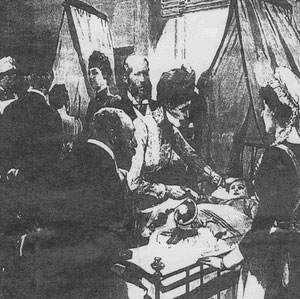
We've been caring for children and young people for over 150 years
Watch a special BBC report about our history.
News anchor: OK now to a place that's described as a hospital that doesn't feel like a hospital. I'm referring to Evelina London which treats children many of whom have long-term health problems. It opened back in 1869 which means of course that it's 150 years old this year, Victoria Hollins has been looking at its history and its life-saving work.
Reporter: This was a hospital built from love, founded in 1869 in one of the poorest parts of Southwark, it was funded entirely by Baron Ferdinand de Rothschild after his wife Evelina died in childbirth. The hospital was considered a model institution with light airy wards, today a plaque marks the site the original hospital walls form the edge of a small park and as the hospital has moved on so have patient needs.
Prof Cyril Chantler, retired Evelina London consultant: Those diseases were disappearing, the infectious diseases like scarlet fever or rheumatic fever, but what was then becoming important was the recognition that children with heart disease or kidney disease, which was my speciality, they required special provision and they needed to develop the special expertise to look after them.
Archive news report: Doctors and nurses at the Evelina Hospital in London wear casual clothing and a helter-skelter takes centre stage in the lobby.
Reporter: The Evelina opened at its current site in 2005 with 140 beds, it was designed to be a hospital that doesn't feel like a hospital, a name much appreciated by Isabelle Everest who's been a patient for 10 years.
Isabelle: It's kind of like a second home because I come so often. The doctors here a lot slower to tell you and they simplify what they're going to say so, as a young person like me or even older than me, could understand.
Reporter: And you always feel like you can ask questions?
Isabelle: Oh yeah, definitely, I ask a lot of questions!
Reporter: Evelina London is now the second largest provider of children's services in London and it's still growing. And this is the hospital's future a new section of the paediatric intensive care unit. It's part of a brand new ward, the Sky Ward, which will eventually have 28 beds.
Dr Sara Hanna, Evelina London medical director: It's a bit cluttered at the minute but it will be a very lovely working environment.
Reporter: The new ward will open later this year adding to other recent improvements like the new ventilation unit in the clinical research unit.
Dr Sara Hanna: We'd like to provide a comprehensive children's hospital that children in other parts of the country and the world have access to and that's our journey that's what we're trying to provide.
Reporter: Would you not say that you are there yet then?
Dr Sara Hanna: No, no, we're not there yet, no.
Reporter: The hospital has clearly changed beyond recognition in 150 years a modern success out of a 19th century tragedy. Victoria Hollins, BBC London News.

 Prince Edward (later Edward VII) with Princess Alexandra during their visit to the hospital in August 1890.
Prince Edward (later Edward VII) with Princess Alexandra during their visit to the hospital in August 1890.
Built in memory of Evelina
The original Evelina Hospital for Sick Children opened in 1869 on Southwark Bridge Road, London. Funded by Austrian Baron Ferdinand de Rothschild, it was built in memory of his wife, Evelina. Evelina had died three years earlier along with their son. Rothschild wanted to open a maternity hospital, but was persuaded by his friend Dr Arthur Farre, a famous obstetrician and physician to the Queen, to open a children’s hospital for the poor.
The latest design
The new four-storey hospital was located south of the river Thames and was described as having ‘the very latest design concepts’, including ‘a quarantine ward for doubtful cases’, ‘abundant provision for the most perfect ventilation’ and ‘large and cheerful rooms, one of which will be for cases of whooping-cough and its complications’, ‘with no expense spared to make this a model hospital’.
Growing hospital
When the hospital first opened, patients with infectious fevers and children under two years old were not allowed. These rules were repeatedly ignored by doctors and eventually overturned. By 1900, over 50% of admissions were babies and toddlers.
In the first year, over 300 children were admitted to the hospital’s 30 beds. By 1900, bed numbers had doubled, with over 1,000 admissions and more than 20,000 children visiting the hospital each year.
Other children’s hospitals, including Great Ormond Street, had a convalescent home where they discharged patients; however Evelina did not have one until 1931. Children were sent to seaside and country homes, which was paid for by a fund.
From 1896-1907, thanks to public donations, Evelina was able to have:
- electric lighting
- a new isolation ward
- an additional floor
- an expanded outpatient department
- x-ray facilities
- a new operating theatre
- a roof garden.
Second World War
During the Second World War, Evelina closed to inpatients as it served as a casualty post.
It was hit by bombs three times during the blitz; 1940, 1941 and 1944.
Evelina moves to Guy’s
Following the creation of the National Health Service in 1948, Evelina merged with Guy’s Hospital and moved to the newly opened Guy’s Tower in 1973. Several of the children’s wards in Guy’s Tower were named after those who had contributed to the original hospital, including Rothschild, Arthur Farre and Caleb Diplock.
Over the next 30 years, as hospital services for children became more specialised, the children’s department developed a worldwide reputation in a number of areas, including children’s heart surgery, nephrology and neurology.
Evelina moves to St Thomas’
In 2005, Evelina moved to St Thomas’ Hospital. The award-winning building was designed around the needs of the children, their families and staff to provide the best possible care. The result is ‘a hospital that doesn’t feel like a hospital’ with state-of-the-art equipment and services. Evelina London was the first new children’s hospital to be built in London for over 100 years, and it is now the second largest provider of children’s services in London.
Since its relocation to St Thomas’, two new operating theatres have been built.
Highly specialist children’s services
Today, Evelina London Children’s Hospital offers a wide range of services meeting the needs of south London’s children while offering highly specialist care for children from across south east England and beyond.
 Thank you to the children and young people who have so brilliantly illustrated our history pages.
Thank you to the children and young people who have so brilliantly illustrated our history pages.